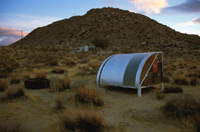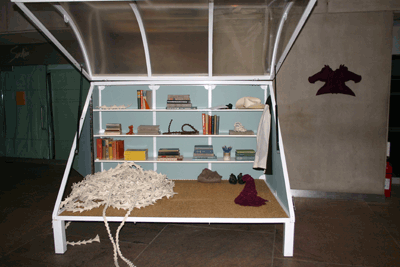Recently I attended a panel at the Whitney curated by Andrea Zittel. Andrea and her friends who live at Joshua Tree talked about their influences and experiences on building community in the context of art. Here’s what the Whitney had to say about the event:
“Well known for her research and design of domestic and external environments, Andrea Zittel creates experimental models for contemporary life, or what she calls “systems for living.” Her current project, the desert studio and home A-Z West in Joshua Tree, California, explores all aspects of the everyday, from home furniture and house guests to food and clothing, as part of her investigation into the contours of human nature and human needs. One such A-Z project, Wagon Stations, comprises mobile living stations customized by individuals invited to join Zittel’s desert community; several will be on view beginning February 9 at the Whitney Museum at Altria.”
I’ve always liked Andrea Zittel. I first saw her work at the Whitney where she had a film on her daily routine as an artist at Joshua Tree. I appreciated it because the film had a great sense of humor. And then, of course, there’s the desert. As Andrea herself has to say of the desert: “After living in the desert for six years, I have come to believe that most of us are drawn here because each of us is looking for some version of personal freedom.” The A-Z wagons represent small, portable structures, customized by each artist, an ode to personal freedom. Traveling through the desert in my RV, painting, I can totally relate to the need for a space of one’s own, even better if we can take it with us on our art journeys.

A Wagon in It’s Native Environment

A Wagon Station from the installation at the Whitney, Altria
The panel itself meandered across a lot of different territories, from activist 60s art to camping out in a large tent in the middle of the Freize Art Fair, in London. What struck me, however, was just how much fun these artists were having being artists. They seemed to live in a world so far removed from our ordinary world of “getting ahead” and commercial considerations. How refreshing! This is what it must be like to live fully in the artist archetype, not an small pokey garret, starving but noble, but in a world of childlike wonder, innocence, creating magnificent worlds of your own choosing, without regard to whether of not anyone else gets it. I can’t remember the last time I felt like that – probably the last time I was out in the desert.
Further thoughts from “The Artist’s Mentor”:
“In one of his letters from Tahiti, Gaugin had written that he felt he had to go back beyond the horses of the Parthenon, back to the rocking-horse of his childhood. It is easy to smile at this preoccupation of modern artists with the simple and the childlike, and yet it should not be hard to understand it. For artists feel that this directness and simplicity is the one thing that cannot be learnt. Every other trick of the trade can be acquired. Every effect becomes easy to imitate after it has been shown that it can be done. Many artists feel that the museums and exhibitions are full of works of such amazing facility and skill that nothing is gained by continuing along those lines; that they are in danger of losing their souls and becoming slick manufacturers of paintings or sculptures unless they become as little children.
— E.H. Gombrich

“The Artist’s Mentor : Inspiration from the World’s Most Creative Minds” (Ian Jackman)
Technorati Tags: art, artists, culture, desert, journeys, women